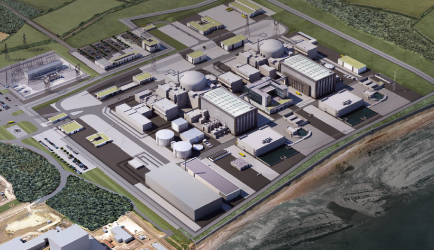Having failed to demonstrate that nuclear power is cheap or safe, the nuclear industry and its supporters have turned to climate change for a selling point. They say that nuclear power is a "low carbon" source of electricity. They have been working to get states and nations to classify nuclear power as low carbon in order to get special consideration. The government of the U.K. is pushing for massive investment in nuclear power on the low carbon argument. (In this post, references to carbon emissions are intended to include any other greenhouse gas, such as methane, that might be emitted by power generation.)
The U.K. Committee on Climate Change (CCC) has said that in order to ameliorate climate change, "by 2030 all electricity should be generated with less than 50 grams of carbon dioxide emitted for each kilowatt-hour (50 gCO2/kWh)." A recent paper in Energy Policy reviewed the Life Cycle Analysis of renewable energy sources with respect to carbon emission and concluded that all the sources studied came in under the 50 gram limit. Hydro power was lowest at about 10 grams. Biogas generated by anaerobic digestion was about 11 grams. An average figure for wind power is around 34 grams. PVC solar power is very close to 50 grams but that number is going down steadily.
There have been studies of carbon emissions from the construction and operation of nuclear power plants but there is no scientific consensus on their average carbon emissions. There have been over three hundred papers published in scientific journals about the carbon emissions for nuclear power. A recent meta-analysis of a hundred papers were winnowed down to twenty studies that were rigorous in their approach. The average carbon footprint for nuclear power was around 66 grams, which is more than thirty percent over the CCC limit. Another meta-analysis took two hundred and seventy five studies and winnowed them down to a hundred studies finding that half the studies were lower than 13 grams. This analysis was critiqued with respect to assumptions about modeling that were questionable because they did not deal with all five stages of the life cycle of nuclear power.
Construction, operation, fuel production, dismantling and waste disposal at a nuclear power plant all emit carbon dioxide. If life cycle analyzes do not include all of these then the estimate of carbon emission will be much lower. The contribution from fuel production will vary in proportion to the concentration of uranium ore that is being mined and refined. A meta-analysis of the meta-analyses yielded eight analyses that were rigorous and thorough. Half were above 50 grams and half were below. Further examination indicated that the varying concentration of uranium ore and the assumptions about the energy that has to be provided during the extraction, preparation and enrichment accounted for some of the wide variation. Assumptions with respect to decommissioning a nuclear power plant and disposing of nuclear waste also contributed to the variation.
As high grade uranium ore is exhausted and lower grades are exploited, the net gain in energy diminishes. When the ore concentration falls below .005%, it is estimated that the carbon footprint of the nuclear plant will be bigger than an equivalent natural gas power plant. It is also estimated that the energy consumed during the life cycle of a nuclear power plant may actually be more than all the energy ever generated by the plant.
The new Hinkley Point C reactor being built in the U.K. may not be finished before 2030 and it will be subsidized as low carbon for thirty five years. This is far too late to have any effect on carbon emissions for decades. With respect to carbon emissions, when subjected to the refined analysis methodology discussed above, there is no strong argument that can be made that the power plant will fall below 50 grams. The estimation of 6 grams made by promoters of the plant is unsupportable, even though it is being used to court investors and get the low carbon subsidy.
Artist's concept of Hinkley Point C:
